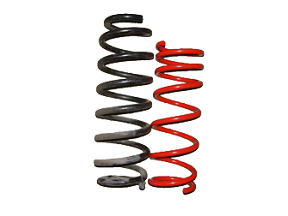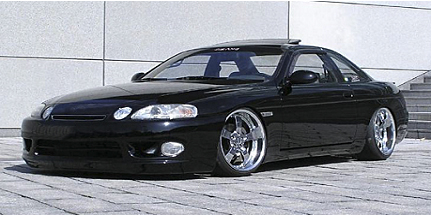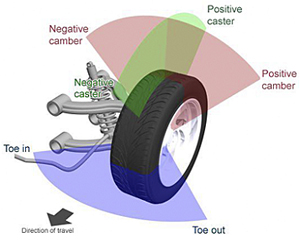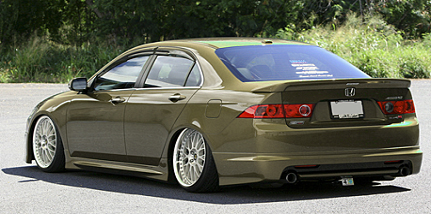Hello, Sign In!
LOWERING YOUR RIDE
Andy's Auto Sport receives a lot of questions regarding lowering components and how they work, so we've compiled a list of common lowering parts and their basic functions. Hopefully you will learn a
thing or two, and will have enough information to decipher some of the jargon common to the lowered suspension industry.
Methods of Lowering
Lowering Springs
Stock coil spring (left) vs. lowering spring (right)

The most common method of lowering today's vehicles is to install a set of lowering springs. These springs are generally shorter than your factory springs, but can feel softer or stiffer than stock
depending on the manufacturer and particular spring model. You see, some lowering springs are made for performance, while others may be mostly for looks (which isn't a bad thing, as some people will want to maintain
a plush factory ride). In many cases, you'll get the most benefit out of your lowered stance with the addition of performance shocks or struts, as your factory units may not work well at their new height. However,
many people do choose to retain their factory struts or shocks if the ride isn't too harsh. Lowering springs are definitely a great way to get the look and performance you want at a great pricepoint. Andy's sells a
lot of springs, so we know that a lot of people agree that they're an easy and effective way to lower your vehicle.
Coilovers
Coilover with height adjustment only (left) vs. coilover with height and preload adjustment (right)

A more performance-minded step up from lowering springs available for many cars is the coilover suspension setup, which combines a threaded shock/strut body with a narrow coil spring, and can be adjusted
up or down to customize your vehicle's ride height. Many coilovers today are dual-adjustable, which means that the shock body length can be adjusted independently of the coil spring height, making it possible to change
ride height without affecting spring preload (the tension between the spring and the spring perches). How can you tell the difference? Single-adjustable coilovers will have only one set of collars, while dual-adjustable
coilovers will have a second set below the adjustable spring perches/collars which set the shock body in place. Many coilovers also come with shocks with adjustable rebound and compression damping settings to fine-tune
ride quality and performance, and may include "pillowball" camber plates to allow for easy alignment changes. In many cases, you won't need to install corrective camber bolts unless there is not enough adjustment in the
camber plates for your needs. Coilovers are often even easier to install than lowering springs, as the whole shock and spring assembly is replaced with a coilover unit at once, and you can even swap out the coils themselves
with springs of lower or higher spring rates to further tune ride quality and performance.
How Low Should I Go?
A question that we get asked often is something along the lines of, "I just bought a [insert vehicle make and model here], and I now want to lower it. How much should I lower it?" To be truthful, there are
so many variables (intended usage, tire size, owner preference) that it would be almost impossible to suggest a "one size fits all" drop, even for one particular make and model. What one person considers a mild drop might
be "slammed" to someone else, so the best thing to do is to take measurements of your vehicle from the top of your wheel arches to the center of your wheels to get a baseline, then take the drop measurements we provide in
each product description to see how much lower your ride will be compared to its existing height.
Just to get you started, here are some examples of various lowered vehicles, along with the approximate amount of each drop:
2011 BMW M3, 1.0-inch front, 0.6-inch rear (stock vs. lowered)

2006 Mazda RX-8, 1.5-inches front, 0.7-inch rear (stock vs. lowered)

2006 Ford Mustang GT, 1.2-inch front, 1.25-inch rear (stock vs. lowered)

2009 Chevrolet Colorado, 2 inches front and rear (before and after)

Reaching Extreme Lows
Lexus SC300 with lower collars removed from coilovers and shocks at lowest setting

In addition, some people just aren't happy with the stance that the average lowering kit provides, so they will resort to modifying their suspension even further - cutting springs, removing adjustment collars
from coilovers to squeeze every last drop of lowness from their suspension, combining multiple suspension parts, etc. There really is no limit to what many hardcore enthusiasts will do to get the ultimate drop. However, with
all that extra work comes the pitfalls - voided warranties, severely reduced scrub lines (the lowest part of your chassis) and road clearance, and of course, tire rubbing. While we love the look of a slammed ride, we urge
those of you who want to take things to the next level to make those modifications in a safe manner, which means not doing things like heating or clamping springs, cutting pigtail springs, or basically doing anything that
is beyond your skill level. And yes, there are always airbag suspensions for the ultimate low (which we also carry here at Andy's Auto Sport), but that's a whole other enchilada that we address in detail in the Air Suspension
section of our website.
I Have Achieved Lowered Supremacy...Now What?
Once your car or truck is sitting much closer to terra firma, there will be a couple of other issues to button up before you hit the local cruise spot or the track. If your vehicle is more than a few years old,
you may want to consider replacing all of your suspension bushings with rubber or polyurethane units. Also, your alignment is now likely to be way out of whack, but it can often go well beyond the standard camber adjustment.
Typical alignment settings for most vehicles

Camber
Acura TSX exhibiting positive camber (front) and negative camber (rear)

Well, let's go ahead and take care of the camber thing. As your suspension is lowered, your factory suspension arms will often arc beyond a point to which they are accustomed. On a vehicle equipped with upper
control arms, this will often result in negative camber, which means that the tops of your wheels will be bowed in, giving you a much smaller tire contact patch. On many strut-equipped vehicles, the car will actually achieve
positive camber due to the way the suspension travels, and you will again have issues with too little tire meeting the ground. Oftentimes this can be adjusted out at your local alignment shop, but if your vehicle has struts
we really recommend purchasing an aftermarket camber bolt kit or camber plates (which are standard equipment with many coilover kits, or can be purchased separately) to bring your wheels back into spec since your factory
hardware likely won't have enough adjustment available. For independent rear suspensions, aftermarket upper control arms are advisable to bring your alignment back in. In all cases, Andy's has what you need, so just check
out what we have to offer.
Living the Low Life
Lowering your vehicle is one of the most satisfying things you can do to achieve your goals of having a truly unique ride. Aside from making your vehicle look a lot better and more aggressive, you can also
often improve handling by bringing your chassis closer to the ground. But don't forget - a lower stance means reduced road clearance, so always be a little more cautious when driving a lowered vehicle and don't hit those
speed bumps too hard!
